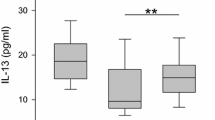Abstract
Chronic secretory otitis relates to the permanent presence of secretion in the middle ear for more than 3 months. The reason why applied therapy is often ineffective is that, for now, etiopathogenic molecular mechanisms responsible for the cause and the course of the secretory process in the mucus of the middle ear have not been precisely defined. Cytokines are the key mediators in middle ear inflammation with secretory otitis and regulating different inflammation states can add to the cause of the molecular processes that lead to hystopathological changes in mucus and submucus characteristically for the chronic state of secretory otitis. The aim of our work was to define the pro-inflammatory, immunoregulatory and allergy-associated cytokine levels in middle ear secretion samples of diseased children and to compare the defined values with the secretory process continuance in groups of patients who were diseased for more or less than 3 months. According to the results that have showed higher concentration of all ten examined cytokines in the secretion samples of the children who had secretory otitis for a longer time, it can be concluded that the disturbance expression regulation of the pro-inflammatory TNFα, TNFβ, IL1β, IFNγ, IL-6 and IL-8, as well as immunoregulatory IL-2 and IL-10, and allergy associated cytokines IL-4 and IL-5 relating to the hyper production can add to the conversion of the inflammatory process to the chronic state, which has been maintained for longer than 3 months.
Similar content being viewed by others
References
Bernstein JM (1996) Role of allergy in eustachian tube blockage and otitis media with effusion: a review. Otolaryngol Head Neck Surg 114:562–568
Byngton CL (1998) The diagnosis and management of otitis media with effusion. Pediatric Annals 27:96–101
Chung MH, Choi JY, Lee WS, Kim HN, Yoon JH (2002) Compositional difference in middle ear effusion: mucous versus serous. Laryngoscope 112:152–155
Forsèni M, Bagger D, Hultcrantz M (2001) A study of inflammatory mediators in the human tympanosclerotic middle ear. Arch otolaryngol 127:559–564
Goycoolea MV (2001) Gland formation in otitis media: an ultra structural study in humans. Acta Otolaryngol 121:182–184
Liderman EM, Post JC, Aull JJ et al (1998) Analysis of adult otitis media: polymerase chain reaction versus culture for bacteria and viruses. Ann Otol Rhinol Laryngol 07:10–16
Himi T, Suzuki T, Kodama H, Takezawa H (1992) Immunologic characteristics of cytokines in otitis media with effusion. Ann Otol Rhinol Laryngol 157:21
Liderman EM, Post JC, Aull JJ et al (1998) Analysis of adult otitis media: polymerase chain reaction versus culture for bacteria and viruses. Ann Otol Rhinol Laryngol 07:10–16
Lin J, Tsuprun V, Kawano H (2001) Characterization of mucins in human middle ear and eustachian tube. Am J Phisiol Lung Cell Mol Physiol 280:1157–1167
Lin J, Haruta A, Kawano H et al (2000) Induction of mucin gene expression in middle ear of rats by tumor necrosis factor alpha: potential cause for mucoid otitis media. J Infect Dis 182:882
Linder TE, Marder HP, Munzinger J (1997) Role of adenoids in the pathogenesis of otitis media: a bacteriologic and immunohistochemical analysis. Ann Otol Rhinol Laryngol 106:619–623
Maeda K, Hirano T, Ichimiya I, Kurono Y, Suzuki M, Mogi G (2004) Cytokine expression in experimental chronic otitis media with effusion in mice. Laryngoscope 114(11):1967–1972
Maxwell KS, Fitzgerald JE, Burleson JA, Leonard G (1994) Interleukin 8 expression in otitis media. Laryngoscope 104:989–995
Poelmans J, Tack J, Feenstra L (2002) Prospective study on the incidence of chronic ear complaints related to gastroesophageal reflux and on the outcome of antireflux therapy. Ann Otol Rhinol Laryngol 111:933–938
Sato K, Liebeler CL, Quartey MK, Le CT, Giebink GS (1999) Middle ear fluid cytokine and inflammatory cell kinetics in the chinchilla otitis media model. Infect Immun 67:1943
Smirnova M, Birchall J, Pearson J (2002) In vitro study of IL-8 and goblet cells. Acta otolaryngol 122:146–152
Smirnova MG, Birchall JP, Pearson JP et al (2005) Evidence of T-helper cell 2 cytokine regulation of chronic otitis media with effusion. Acta Otolaryngol 125:1043–1050
Takaki M, Ushikai M, Deguchi K et al (2003) The role of nuclear factor-kappa B in interleukin 8 _expression by human adenoidal fibroblasts. Laryngoscope 113(8):1378–1385
Takasaki K, Sando I, Balaban CD, Ishijima K (2000) Postnatal development of eustachian tube cartilage: a study of normal and cleft palate cases. Int J Pediatr Otorhinolaryngol 52:31–36
Tos M, Caye-Thomasen P (2002) Mucous glands in the middle ear: what is known and what is not. ORL J Otorhinolaryngol Relat Spec 64:86–94
Watanabe T, Hirano T, Suzuki M et al (2001) Role of IL-1β in a murine model of otitis media with effusion. Ann Otol Rhinol Laryngol 110:574–580
Yellon R, Doyle W, Whiteside T (1995) Cytokines, immunoglobulins and bacterial pathogens in middle ear effusion. Arch otolaryngol head neck surg 121:865–869
Zielhius GA, Rach GH, Bosch AV, Broek PV (1990) The prevalence of otitis media with effusion:a critical review of the literature. Clin Otolaryngol 15:283–288
Author information
Authors and Affiliations
Corresponding author
Rights and permissions
About this article
Cite this article
Matković, S., Vojvodić, D. & Baljosevic, I. Cytokine levels in groups of patients with different duration of chronic secretory otitis. Eur Arch Otorhinolaryngol 264, 1283–1287 (2007). https://doi.org/10.1007/s00405-007-0373-2
Received:
Accepted:
Published:
Issue Date:
DOI: https://doi.org/10.1007/s00405-007-0373-2




